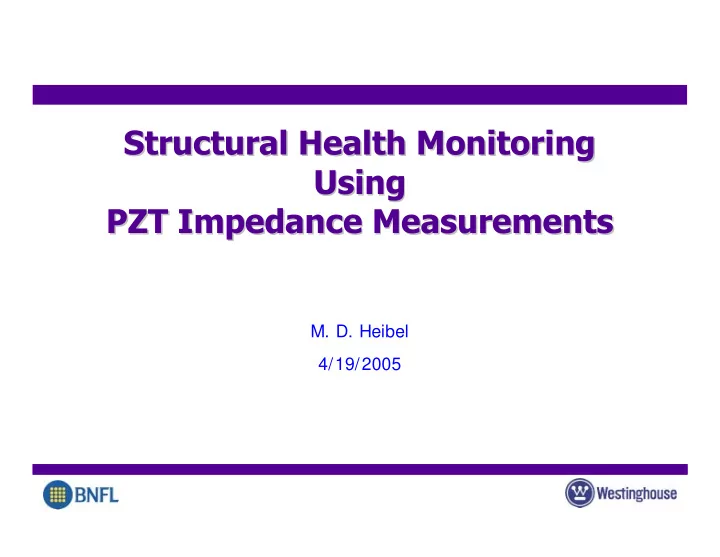

Structural Health Monitoring Structural Health Monitoring Using Using PZT Impedance Measurements PZT Impedance Measurements M. D. Heibel 4/19/2005
Structural Health Monitoring Using PZT Impedance Measurements
Structural Health Monitoring Using PZT Impedance Measurements
Structural Health Monitoring Using PZT Impedance Measurements Principles of the Impedance Method • Excite structures with PZT and measure mechanical impedance changes (>30 kHz) • Qualitative approach to damage detection • Uses small PZTs as co-located actuators and sensors • Detect incipient structural fault, such as cracks or loosening of bolts • Can be remotely controlled, and then, automated • Localized sensing area. Unaffected by changes in boundary conditions, loading, or operational • vibrations • Low excitation forces + high frequencies produce low power requirements • Sensors are small, unobtrusive and inexpensive
Structural Health Monitoring Using PZT Impedance Measurements The mechanical impedance of the structure, at the point of application of the force, is defined as the ratio of the driving harmonic force to the resulting harmonic velocity at that point. Mathematically, it can be expressed as :
Structural Health Monitoring Using PZT Impedance Measurements The constitutive relations for piezoelectric materials under small field condition are (Sirohi and Chopra 2000): where D (3x1) = electric displacement vector (C/m2), S (6x1) = strain vector, E (3x1) = applied external electric field vector (V/m), and T (6x1) = stress vector (N/m2), ε ij T = ε ij T (1 −δ j ) (3x3) = complex dielectric permittivity at constant stress; dimd (3x6) and djkc (6x3) = matrices of the piezoelectric strain coefficients; and skmE = skmE (1 −η j ) (6x6) = matrix of the complex elastic compliance at constant electric field. d denotes the dielectric loss factor and η the mechanical loss factor. The superscripts T and E indicate that the quantity has been measured at constant stress and constant electric field, respectively. The first subscript denotes the direction of the electric field and the second the direction of the associated mechanical strain. Commercially, the piezoelectric materials are available as ceramics, such as lead–zirconate–titanate (PZT) and polymers, such as polyvinvylidene fluoride.
Structural Health Monitoring Using PZT Impedance Measurements
Structural Health Monitoring Using PZT Impedance Measurements • Actuator Signal Split between two branches • One branch contains the piezo and the other a matched capacitance • Vibration of the structure generates a sensing signal • Difference amplifier subtracts out the actuation signal leaving only the sensing signal
Structural Health Monitoring Using PZT Impedance Measurements
Structural Health Monitoring Using PZT Impedance Measurements
Structural Health Monitoring Using PZT Impedance Measurements • The Root Mean Squared Deviation (RMSD) compares differences between individual peaks (Park, et al, 2003) • Zi ,1 is the baseline impedance • Zi ,2 is a curve used for comparison to the baseline • The larger the damage metric, M, the greater the change between curves
Recommend
More recommend